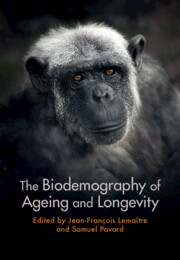Book contents
- The Biodemography of Ageing and Longevity
- The Biodemography of Ageing and Longevity
- Copyright page
- Dedication
- Contents
- Contributors
- Foreword
- Acknowledgements
- 1 The Eternal Youth of Ageing Research
- 2 Theories of Ageing across Ages
- 3 The Diversity of Longevity Metrics
- 4 The Meaning of ‘Exceptional Longevity’
- 5 The Inevitability of Senescence
- 6 The Untapped Potential of Zoo and Aquarium Data for the Comparative Biology of Ageing
- 7 Perspectives in Comparative Biology of Ageing
- 8 An Integrative Approach to Understanding Variation in the Form, Pattern and Pace of Ageing
- 9 Sex Differences in Lifespan, Ageing and Health in the Living World
- 10 Evolution of Human Reproduction, Ageing and Longevity
- 11 Lifespan and Mortality in Hunter-Gatherer and Other Subsistence Populations
- 12 Longevity in Modern Populations
- 13 Health Transition and Population Ageing
- 14 Limit of Human Longevity
- 15 Mortality Modelling at the Oldest Ages in Human Populations
- 16 Lessons from Exceptionally Long-Lived Individuals and Long-Living Families
- 17 Human Populations with Extreme Longevities
- 18 Socio-Economic Consequences of Increased Longevity in Contemporary Populations
- Index
- References
5 - The Inevitability of Senescence
Published online by Cambridge University Press: 14 November 2024
- The Biodemography of Ageing and Longevity
- The Biodemography of Ageing and Longevity
- Copyright page
- Dedication
- Contents
- Contributors
- Foreword
- Acknowledgements
- 1 The Eternal Youth of Ageing Research
- 2 Theories of Ageing across Ages
- 3 The Diversity of Longevity Metrics
- 4 The Meaning of ‘Exceptional Longevity’
- 5 The Inevitability of Senescence
- 6 The Untapped Potential of Zoo and Aquarium Data for the Comparative Biology of Ageing
- 7 Perspectives in Comparative Biology of Ageing
- 8 An Integrative Approach to Understanding Variation in the Form, Pattern and Pace of Ageing
- 9 Sex Differences in Lifespan, Ageing and Health in the Living World
- 10 Evolution of Human Reproduction, Ageing and Longevity
- 11 Lifespan and Mortality in Hunter-Gatherer and Other Subsistence Populations
- 12 Longevity in Modern Populations
- 13 Health Transition and Population Ageing
- 14 Limit of Human Longevity
- 15 Mortality Modelling at the Oldest Ages in Human Populations
- 16 Lessons from Exceptionally Long-Lived Individuals and Long-Living Families
- 17 Human Populations with Extreme Longevities
- 18 Socio-Economic Consequences of Increased Longevity in Contemporary Populations
- Index
- References
Summary
Humans age. Domestic animals age. But is that true for all species? Is ageing a necessary consequence of evolution? Yes - for a long time, this was the undisputed answer of classic evolutionary theories of ageing. This chapter tells the story about how this paradigm of inevitable ageing has been challenged and refuted. Thanks to decades of monitoring individual survival and death across species in captivity and in the wild, researchers have been able to study patterns of the ageing process’s ultimate consequence - age trajectories of mortality. Though ageing is a complex, multiscale process, increasing mortality with age is, overall, indicative of a loss of functioning with age - senescence. Constant or declining mortality with adult age is indicative of maintained or improved functioning - negligible or negative senescence. Evidence supports that ageing patterns across the tree of life are diverse. Whether current evidence for negligible or negative senescence truly reflects an absence of senescence or just an absence of evidence is an open challenge. Similarly, why certain types of species show certain types of senescence patterns is an open research question. Future evolutionary theories of ageing will have to include trade-offs justified by structural arguments - genetic structure, physiological structure, social structure, ecological structure - to explain types of ageing patterns across types of species.
Keywords
- Type
- Chapter
- Information
- The Biodemography of Ageing and Longevity , pp. 69 - 94Publisher: Cambridge University PressPrint publication year: 2024

